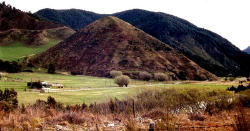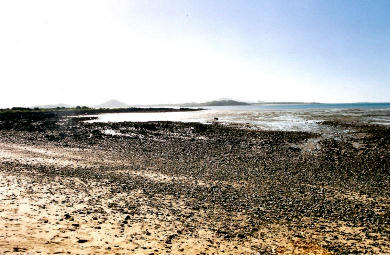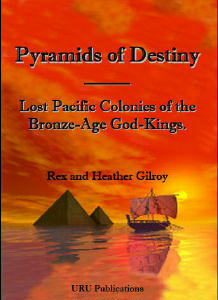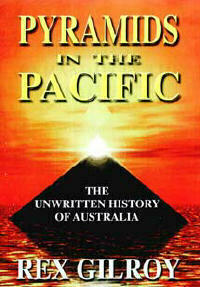
| Pyramids of Destiny – Lost Pacific Colonies of the Bronze-Age God-Kings |
 |
The remains of massive mineral ore smelting operations by the ancient miner-colonists extends for many kilometres along the shoreline far to the north and south of Clairview.
Untold thousands of people had to have been involved in these ancient mining activities.
|
Pyramids of Destiny – Lost Pacific Colonies of the Bronze-Age God-Kings
by Rex & Heather Gilroy
Copyright
© Rex Gilroy 2009
| “Australian history is almost always picturesque; indeed it is so curious and strange, that it is itself the chiefest novelty the country has to offer, and so it pushes all other novelties into second and third place. It does not read like history but like the most beautiful lies. Mark Twain: Following the Equator [1891] |
”Every truth passes through three stages before it is recognised. In the first, it is ridiculed. In the second, it is opposed. In the third, it is regarded as self evident.” Arthur Schopenhauer [1788-1860] |
Part Three.
Lost Egypto-Phoenician Colonies of Queensland’s Far North.
Chapter Fifteen.
In Search of Clairview’s Ancient Thoth Worshippers.
All removable rock inscriptions described in this chapter were removed for safekeeping and research by the authors.In the course of our July-August 2002 Queensland field investigations, which took us as far as Cooktown, we happened to pull into the waterfront village of Clairview. I had received information in the past of possible ancient open-cut mining operations lying hidden in the mountain country to the west of the village, so thought the area was worth investigating.
It was the afternoon of Thursday 25th July, the day that Heather and I discovered our first evidence of what we realised were the remains of yet another ‘lost’ colony of the Bronze-Age God-Kings. Clairview itself stands on the shoreline of Broad Sound, between Marlborough to the south and Sarina to the north. Over a great distance north and south of the village, at low tide [we were to discover on future investigations here] there can be seen at intervals great outcrops of ancient mining slag, the remains of shoreline smelting operations and this extends for some distance out across the vast mudflats exposed by the retreating tide.
Ancient stoneworks are apparent, projecting above the offshore tidal mud. It is apparent that, in antiquity the coastal land extended much further out than it does now. However, the very first time that we walked down onto the beach front at one site the tide was coming in. As it had not yet invaded a lot of basalt rubble that lined the waterfront I left Heather on the beach while I searched among some very large blocks in the hope of finding any tell-tale engravings.
In fact, upon climbing onto a more intact ‘natural’ platform of basalt rocks I could see that it extended for some distance to our south, and that allowing for the huge blocks tumbled about by centuries of storms and tides, this extensive platform was an ancient man-made structure, a great stone wharf.
The structure had once extended far out to what are now mudflats at low tide. Here triremes and other craft had once docked with supplies and livestock, or transported precious metals, gemstones, timber and other goods northwards via south-east Asian lands to India and the Red Sea ports. It is also likely that at sometime a lot of this cargo was carried to Sarina, up the coast from Broad Sound, where a mighty colony arose.
As I stood there gazing into the past, I realised time was moving on and we had to be on our way. Heather was waiting impatiently at the car as the sun began to sink over the mountains. As I left the crumbling wharf I suddenly came upon a large, water worn limestone head. As I was carrying my backpack and cameras [which I have with me at all times] I quickly removed them all and set about sketching, photographing and measuring this relic. I called out to Heather who soon joined me.
Great ages of wear caused by time and tide had robbed the head of most of its features, but for two large deep round eyes, the remains of a long nose and a deeply carved round mouth. The image looked Phoenician and measured 53.5cm in length by 40cm width and was at least 36cm in depth. A quick search of the immediate sand-covered area in which the relic lay failed to find any further associated remains. After hastily measuring the area so as to relocate this head later, we left as darkness overtook our operations.
We returned to Queensland in August 2003. Prior to our arrival in Sarina where we were already investigating the mass of evidence of Bronze-Age colonisation of that district, we stopped at Clairview to begin a full-scale investigation of this colony.Clairview faces Long Island across Broad Sound, and we wondered what might lie hidden on that island, telling of ancient mining operations two to three thousand years or more in the past. The thousands of tonnes of ancient mineral slag lying along the beachfront and mud flats for kilometres shows that the inland mines produced gold, silver, lead, tin and copper in great quantities.
Hundreds of miners must have been involved in the extraction of these minerals, and hundreds more workers laboured on other duties. Farms had to have been established to help feed the colonists. Children grew up here while their mothers baked bread and cooked meals for the family, or worked in bakeries built on the sites of the mines to provide food for the workers.
We could imagine vessels docking at the great stone wharf where a hive of activity involving great numbers of people was a daily routine.
Signs of ancient smelter remains were detected in the mud-covered rubble, surrounded by heaps of slag. As the tide was out it was possible for us to search among the rubble for relics and other signs of ancient settlement.
Oysters and other shellfish coated the remains of ancient ruins mostly buried in the tidal mud and I found a two tiered formation of small stone blocks coated in sea life which may have served as an altar when the site was high up on dry land.
We had arrived here at 1.30pm and one of the first things we did was to relocate the stone head found on our first visit. It was possible, we thought, that this head was another image of Baal, perhaps part of a long-vanished body which had once stood in a small shrine, or even in a temple long ago swept away by centuries of tides. We took more photographs in better sunlight, and soon afterward, I caught sight of something that had been overlooked here half an hour earlier – two small oddly-shaped stones.
They turned out to be a female figure and a one eyed image holding a Sun-disc. These little images half-buried in the sand were startling finds in themselves, for the female image bore the Phoenician letterings ‘T’ and ‘N’, short for “Tanit [aka Tanith], the Earth –Mother Goddess of the Phoenicians. The stone measured 13cm tall by 7.7cm width and 3cm thick.
The other image, carved upon a round, thin stone, measuring 7.5cm tall by 6.4cm width and 1.2cm thick was that of a one-eyed male figure holding a Sun-disc in his right hand, with a large Sun-disc on his chest. These were obvious votive offering images from a temple, and therefore we reasoned that the large stone head, probably that of Baal and part of a vanished body, once stood in a sizeable megalithic temple on the wharf, of which now only large tumbled stone blocks remained. Yet the ruins of this temple were about to reveal another treasure from the past
I had no sooner labelled and wrapped these two small images in plastic bags, when chancing a walk a few metres north of the large stone head, I happened to notice a curiously-shaped rock wedged between two basalt blocks projecting up out of the sand. Curiosity made me try and remove it, which at first proved almost impossible. I was about to give up, thinking it might only be an oddly-shaped rock anyway, when I decided to try and remove the shell grit that wedged the specimen so tightly.
This proved more successful than trying to tug the rock out. It was then that I realised that I was holding a limestone image of a little squatting baboon-type figure.
Main Book Index | Mysterious Australia Homepage | URU Homepage | Australian Yowie Research Centre

